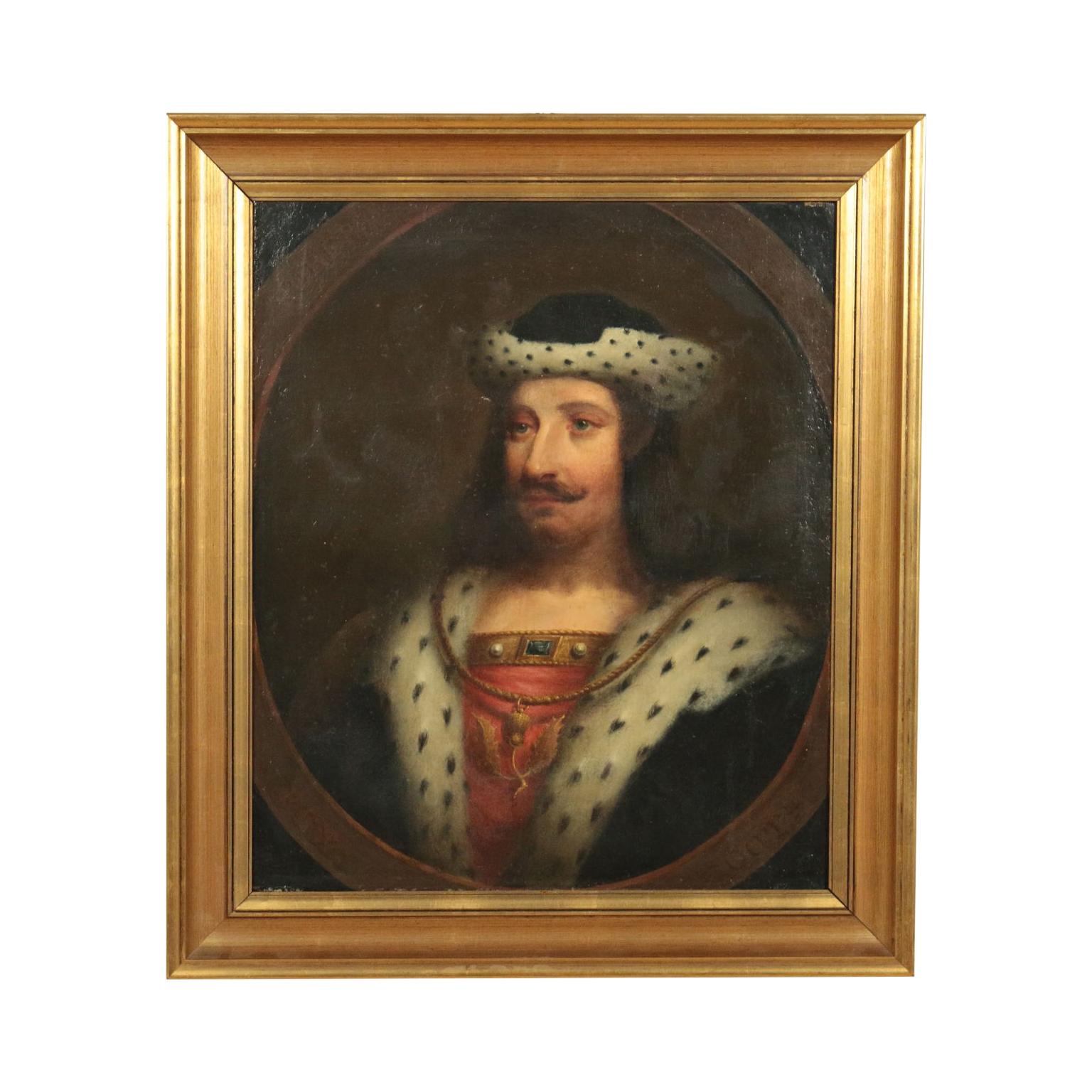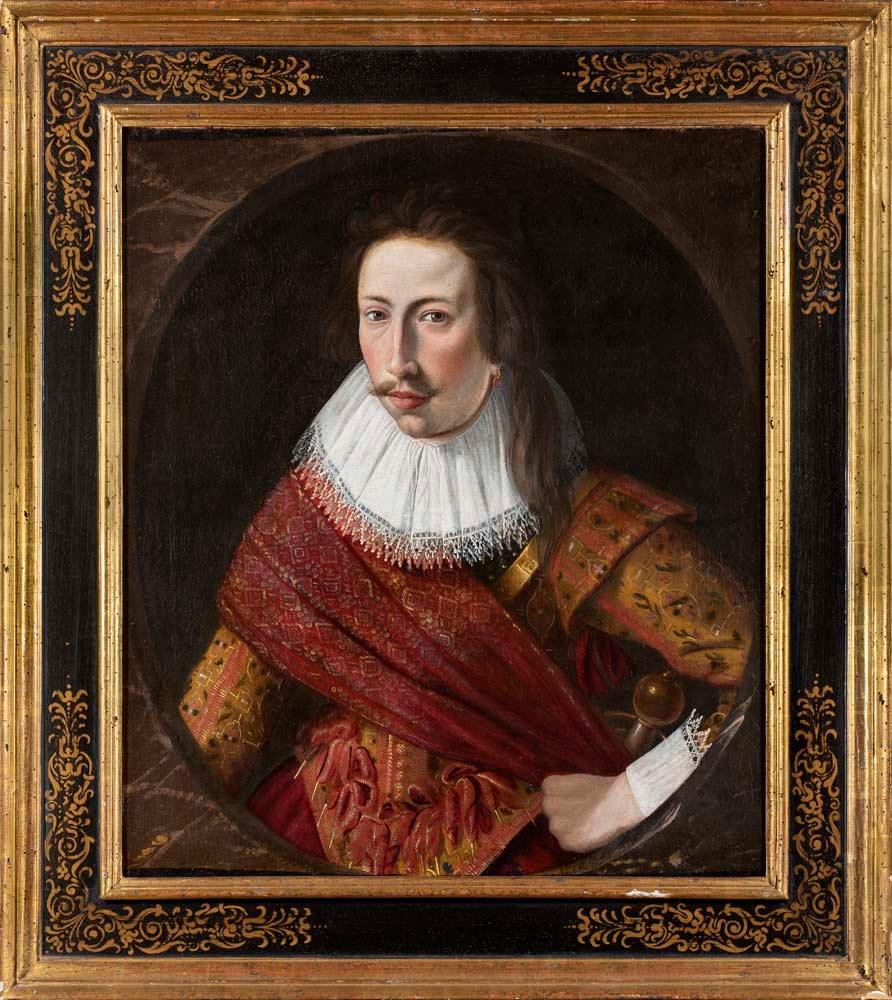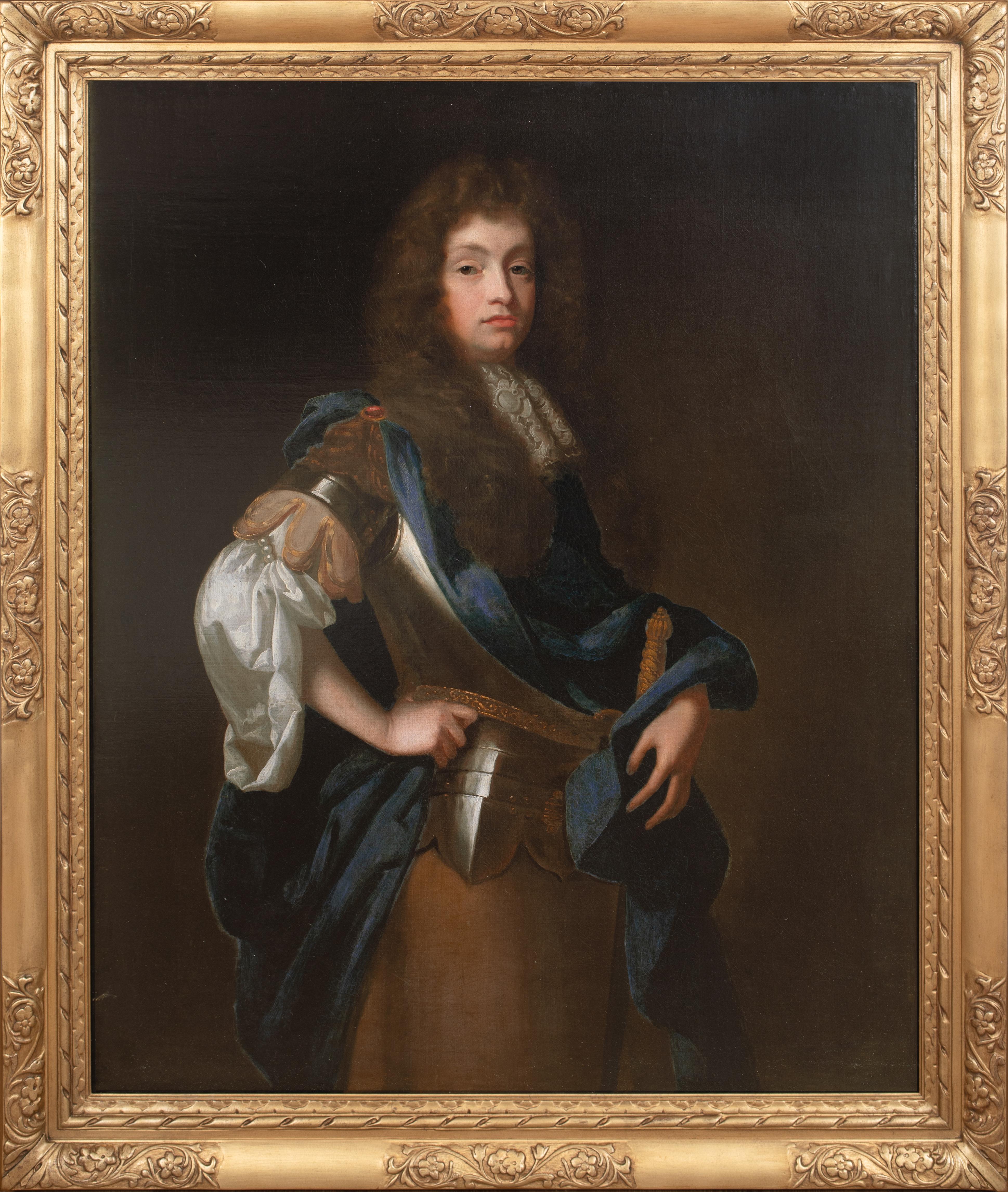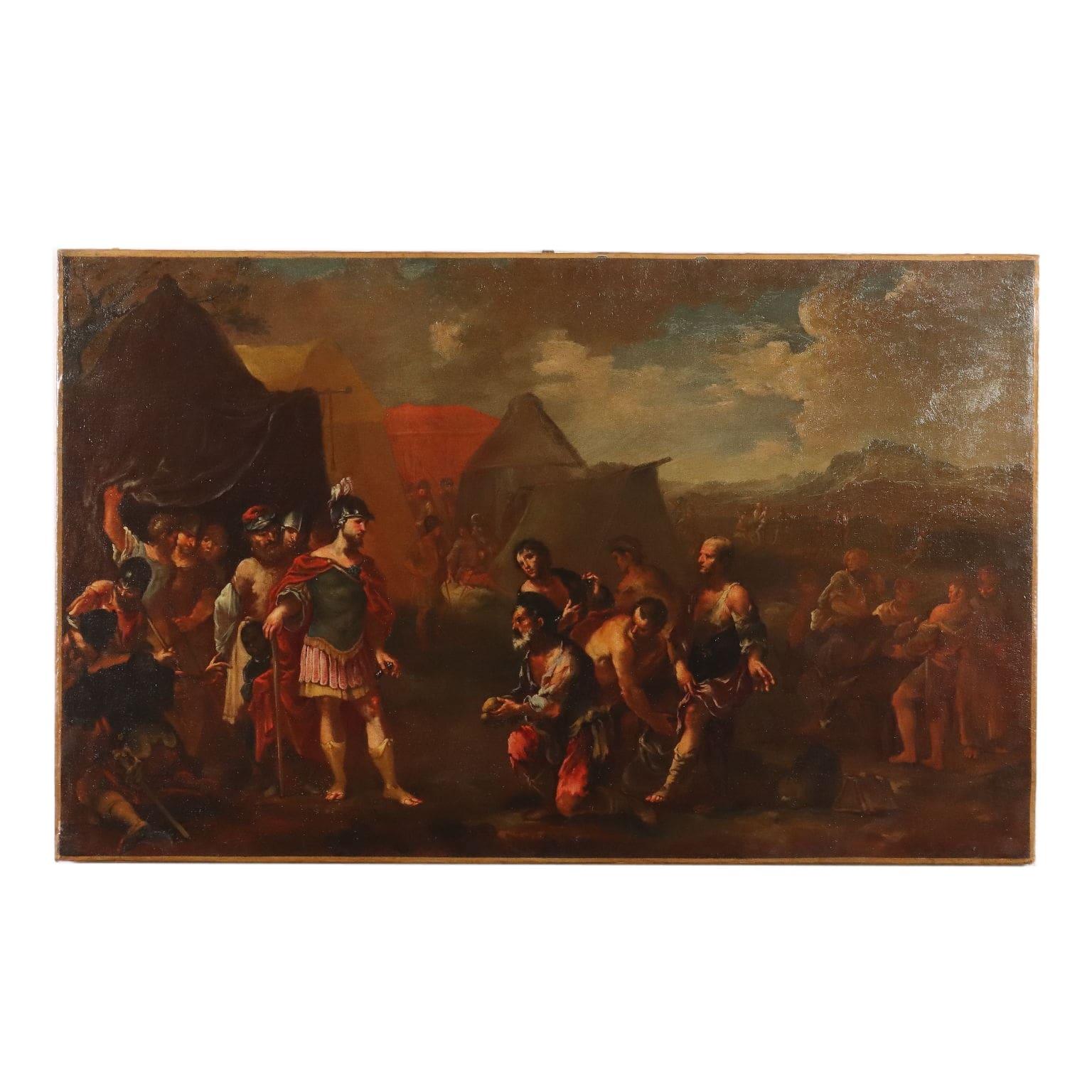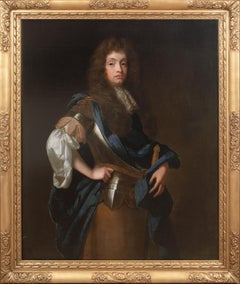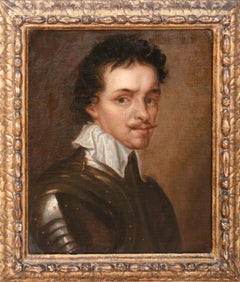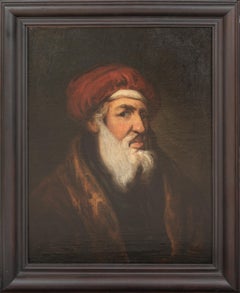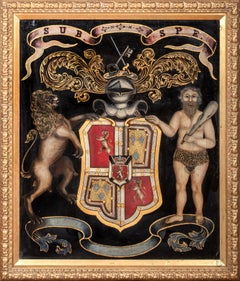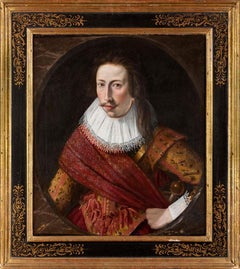Items Similar to Fergus Mór Mac Eirc, Fergus II King Of Scotland (430-501), 17th Century
Want more images or videos?
Request additional images or videos from the seller
1 of 14
UnknownFergus Mór Mac Eirc, Fergus II King Of Scotland (430-501), 17th Century
$6,517.33
$8,146.6620% Off
£4,800
£6,00020% Off
€5,631.55
€7,039.4320% Off
CA$9,134.72
CA$11,418.4020% Off
A$9,921.96
A$12,402.4520% Off
CHF 5,252.85
CHF 6,566.0620% Off
MX$119,801.54
MX$149,751.9320% Off
NOK 65,576.48
NOK 81,970.6120% Off
SEK 62,123.30
SEK 77,654.1320% Off
DKK 42,050.28
DKK 52,562.8520% Off
About the Item
Fergus Mór Mac Eirc, Fergus II King Of Scotland (430-501), 17th Century
European School - Early Oil On Panel
17th Century European School portrait of Fergus II King of Scotland, oil on panel. Rare early and important historical portrait of the Gaelic King and one of the early founders of Scotland. Portrayed at full length wearing his distinct thorned crown in armour, cape and holding a sceptre. Presented in an early antique gilt frame.
Measurements: 18.5" x 14" framed approx
- Dimensions:Height: 18 in (45.72 cm)Width: 18 in (45.72 cm)
- Medium:
- Period:
- Condition:
- Gallery Location:Blackwater, GB
- Reference Number:1stDibs: LU1577214419882
About the Seller
4.9
Vetted Professional Seller
Every seller passes strict standards for authenticity and reliability
Established in 2008
1stDibs seller since 2021
301 sales on 1stDibs
Typical response time: 2 hours
- ShippingRetrieving quote...Shipping from: Blackwater, United Kingdom
- Return Policy
Authenticity Guarantee
In the unlikely event there’s an issue with an item’s authenticity, contact us within 1 year for a full refund. DetailsMoney-Back Guarantee
If your item is not as described, is damaged in transit, or does not arrive, contact us within 7 days for a full refund. Details24-Hour Cancellation
You have a 24-hour grace period in which to reconsider your purchase, with no questions asked.Vetted Professional Sellers
Our world-class sellers must adhere to strict standards for service and quality, maintaining the integrity of our listings.Price-Match Guarantee
If you find that a seller listed the same item for a lower price elsewhere, we’ll match it.Trusted Global Delivery
Our best-in-class carrier network provides specialized shipping options worldwide, including custom delivery.More From This Seller
View AllPortrait Of Richard Jones, 1st Earl Of Ranelagh, 17th Century SIR PETER LELY
By Sir Peter Lely
Located in Blackwater, GB
Portrait Traditionally Identified as Richard Jones, 1st Earl Of Ranelagh, 17th Century
School Of Sir Peter Lely (1618-1680)
Large 17th Century Portrait believed to be Rochard Jones...
Category
17th Century Portrait Paintings
Materials
Oil, Canvas
$9,775 Sale Price
20% Off
Portrait Thomas Wentworth, 1st Earl of Stafford (1593-1641), 17th Century
Located in Blackwater, GB
Portrait Thomas Wentworth, 1st Earl of Stafford (1593-1641), 17th Century
Circle of Anthonius VAN DYCK (1599-1641)
Fine 17th century English School Old Master portrait of Anthonius...
Category
19th Century Portrait Paintings
Materials
Canvas, Oil
$8,689 Sale Price
20% Off
Portrait Of Identified as Topal Osman Pasha (1663–1733), 18th Century
Located in Blackwater, GB
Portrait Traditionally Identified as Topal Osman Pasha (1663–1733), 18th Century
Italian School
Large 19th Century Italian School Ottoman portrait identified as Total Osman Pasha, oil on canvas. Circa 1730 profile portrait of the Ottoman military...
Category
17th Century Portrait Paintings
Materials
Oil, Canvas
$3,801 Sale Price
20% Off
Clan Murray, Coat Of Arms, Duke Of Atholl, 18th Century Scottish School
Located in Blackwater, GB
Clan Murray, Coat Of Arms, Duke Of Atholl, 18th Century
Scottish School
Large 18th Century Scottish Clan Murray Coats of Arms, oil on canvas. The shield bearing allegiance to the c...
Category
18th Century Portrait Paintings
Materials
Canvas, Oil
$4,378 Sale Price
20% Off
Portrait Of John Parker, 1st Lord Boringdon (1735-1788), 18th century
By Joshua Reynolds
Located in Blackwater, GB
Portrait Of John Parker, 1st Lord Boringdon (1735-1788), 18th century
School of Joshua Reynolds (1723-1792)
Large 18th portrait of John Parker, 1st Lord Boringdon, oil on canvas. E...
Category
18th Century Portrait Paintings
Materials
Canvas, Oil
$5,974 Sale Price
20% Off
Imas Coat Of Arms, Innes Clan, Sir Robert Innes, 17th Century McInnes family
Located in Blackwater, GB
Imas Coat Of Arms, Innes Clan, Sir Robert Innes, 17th Century
Scottish School
17th Century Scottish Imas Coat Of Arms to the Innes Clan, oil on canvas laid down. Early Innes clan c...
Category
17th Century Figurative Paintings
Materials
Oil, Wood Panel
$1,683 Sale Price
20% Off
You May Also Like
Portrait Knight Paint Oil on canvas 17th Century Lombard school Old master Italy
Located in Riva del Garda, IT
Lombard painter of the 17th century
Portrait of a Knight in Armour
Oil on canvas
81 x 70 cm./ Framed 93 x 82
A handsome gentleman in armour, immortalised in an authoritative and pr...
Category
17th Century Old Masters Paintings
Materials
Oil
$6,015 Sale Price
20% Off
Portrait Of A Scottish Monarch Oil On Canvas 19th Century
Located in Milan, IT
Oil on canvas. Intense and high quality, the painting depicts a monarch of the royal house of Scotland.
Around the portrait, in a painted oval frame, there are some writings: the name Rober(t) appears at the top left, the title Rex at the bottom left and the abbreviation Scot, which stands for Scotorum, on the right; the writing at the top right is not identifiable, but it seems to be an acronym.
The man portrayed wears a hat and a coat adorned with ermine fur, which is considered the noblest fur, reserved for royalty. He wears a golden pendant around his neck, which depicts two leaves with the fruit of the thistle, which, in heraldry, symbolizes Scotland.
The writing and the pendant therefore refer to a Robert of Scotland, probably from the dynasty that reigned in the fourteenth century.
The portrait was however executed in the romantic nineteenth-century period, probably using some ancient engravings...
Category
19th Century Other Art Style Portrait Paintings
Materials
Oil
$9,977 Sale Price
20% Off
Portrait of an Officer, Cornelius Johnson, 17th Century Old Masters
By Cornelius Johnson
Located in London, GB
Circle of Cornelius Johnson
Circa 1620’s
Portrait of a Officer
Oil on canvas
Image size: 28 x 24 inches
Period style hand made frame
Provenance
Private European Estate
This striking portrait dates to around 1620, as you can see from the images of the sash the detail is very high. The sash is decorated with gold thread and would have cost a small fortune at the time. Sashes were originally developed for a military function (making officers more visible for their men during combat), but soon became a primarily male fashion...
Category
Early 17th Century Old Masters Portrait Paintings
Materials
Oil
Portrait of William Herbert, 3rd Earl of Pembroke, Early 17th Century Portrait
Located in London, GB
English School, (circa 1600)
Portrait of William Herbert, 3rd Earl of Pembroke
Oil on panel, oval
Image size: 29¼ x 23⅞ inches
Painted wooden frame
Provenance:
176, Collection of Francis Greville, 1st Earl of Warwick.
The Trustees of the Lord Brooks’ Settlement, (removed from Warwick Castle).
Sotheby’s, London, 22nd March 1968, lot 81.
Painted onto wooden panel, this portrait shows a dark haired gentleman in profile sporting an open white shirt. On top of this garments is a richly detailed black cloak, decorated with gold thread and lined with a sumptuous crimson lining. With the red silk inside it’s all very expensive and would fall under sumptuary laws – so this is a nobleman of high degree.
It’s melancholic air conforms to the contemporary popularity of this very human condition, evident in fashionable poetry and music of the period. In comparison to our own modern prejudices, melancholy was associated with creativity in this period.
This portrait appeared in the earliest described list of pictures of Warwick castle dating to 1762. Compiled by collector and antiquary Sir William Musgrave ‘taken from the information of Lord & Lady Warwick’ (Add. MSS, 5726 fol. 3) is described;
‘8. Earl of Essex – an original by Zuccharo – seen in profile with black hair. Holding a black robe across his breast with his right hand.’
As tempting as it is to imagine that this is a portrait of Robert Devereux, the 2nd Earl Essex, we might take this with a pinch of salt. Its identification with this romantic and fatal Elizabethan might well have been an attempt to add romance to Warwick Castle’s walls. It doesn’t correspond all that well with Essex’s portraits around 1600 after his return from Cadiz. Notably, this picture was presumably hung not too far away from the castle’s two portraits of Queen Elizabeth I. The first, and undoubtedly the best, being the exquisite coronation portrait that was sold by Lord Brooke in the late 1970s and now hangs in the National Portrait Gallery. The second, described as being ‘a copy from the original at Ld Hydes’, has yet to resurface.
The portrait eventually ended up being hung in the State Bedroom of Warwick Castle.
Archival documents present one other interesting candidate. The Greville family’s earliest inventory of paintings, made in 1630 at their home Brooke House in Holborn, London, describes five portraits of identified figures. All five belonged to the courtier, politician and poet Sir Fulke Greville (1554-1628), 1st Baron Brooke, and were hung in the ‘Gallerie’ of Brooke House behind yellow curtains. One of them was described as being of ‘Lord of Pembrooke’, which is likely to have been William Herbert (1580-1630), 3rd Earl of Pembroke. William was the eldest son of Greville’s best friend’s sister Mary Sidney, and was brought up in the particularly literary and poetically orientated household which his mother had supported. Notably, the 3rd Earl was one of the figures that Shakespeare’s first folio was dedicated to in 1623.
The melancholic air to the portrait corresponds to William’s own pretensions as a learned and poetic figure. The richness of the robe in the painting, sporting golden thread and a spotted black fabric, is indicative of wealth beyond that of a simple poet or actor. The portrait’s dating to around the year 1600 might have coincided with William’s father death and his own rise to the Pembroke Earldom. This period of his life too was imbued with personal sadness, as an illicit affair with a Mary Fitton had resulted in a pregnancy and eventual banishment by Elizabeth I to Wilton after a short spell in Fleet Prison. His illegitimate son died shortly after being born. Despite being a close follower of the Earl of Essex, William had side-stepped supporting Devereux in the fatal uprising against the Queen and eventually regained favour at the court of the next monarch James I.
His linen shirt is edged with a delicate border of lace and his black cloak is lined on the inside with sumptuous scarlet and richly decorated on the outside with gold braid and a pattern of embroidered black spots.
Despite the richness of his clothes, William Herbert has been presented in a dishevelled state of semi-undress, his shirt unlaced far down his chest with the ties lying limply over his hand, indicating that he is in a state of distracted detachment. It has been suggested that the fashion for melancholy was rooted in an increase in self-consciousness and introspective reflection during the late 16th and early 17th centuries.
In contemporary literature melancholy was said to be caused by a plenitude of the melancholy humor, one of the four vital humors, which were thought to regulate the functions of the body. An abundance of the melancholia humor was associated with a heightened creativity and intellectual ability and hence melancholy was linked to the notion of genius, as reflected in the work of the Oxford scholar Robert Burton, who in his work ‘The Anatomy of Melancholy’, described the Malcontent as ‘of all others [the]… most witty, [who] causeth many times divine ravishment, and a kind of enthusiamus… which stirreth them up to be excellent Philosophers, Poets and Prophets.’ (R. Burton, The Anatomy of Melancholy, London, 1621 in R. Strong, ‘Elizabethan Malady: Melancholy in Elizabethan and Jacobean Portraits’, Apollo, LXXIX, 1964).
Melancholy was viewed as a highly fashionable affliction under Elizabeth I, and her successor James I, and a dejected demeanour was adopted by wealthy young men, often presenting themselves as scholars or despondent lovers, as reflected in the portraiture and literature from this period. Although the sitter in this portrait is, as yet, unidentified, it seems probable that he was a nobleman with literary or artistic ambitions, following in the same vain as such famous figures as the aristocratic poet and dramatist, Edward de Vere...
Category
Early 17th Century Old Masters Portrait Paintings
Materials
Oil, Wood Panel
Painting with Historical Subject 17th-18th Century
Located in Milan, IT
Oil on Canvas.
The scene takes place at a military camp: outside a tent on the left a leader of an army, probably Greek, is receiving offerings of a group of men, poor and ragged, ...
Category
Late 17th Century Other Art Style Figurative Paintings
Materials
Oil
$6,421 Sale Price
20% Off
Antique Italian painter - 18th century figure painting
Located in Varmo, IT
Italian painter (18th century) - Chrono.
90.5 x 106 cm.
Antique oil painting on canvas, without frame (not signed).
Condition report: Lined canvas. Good state of conservation of t...
Category
Early 18th Century Old Masters Figurative Paintings
Materials
Canvas, Oil
$4,721 Sale Price
20% Off
More Ways To Browse
17th Century Oil On Panel Portrait
Antique Oil Portraits 17th Century
Oil Country Scene
Oil Paintings Wales
Pacific Northwest Art
Palm Tree Canvas
Sea Battle
Sierra Painting
Venice Oil 19th Century
1920s Impressionist Painting
Antique Preston
Dorset Painting
Dutch Landscape Painters
Ferry Painting
Flower Pond
French Sailboats Art
Geese Painting
Medaille D Argent
